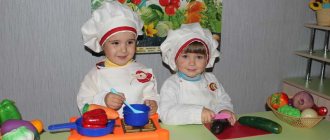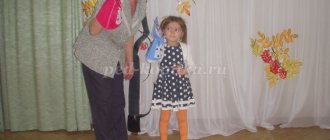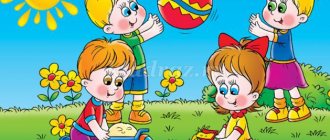Card index of games with nesting dolls
Story game“WHAT ARE THE NESTING DOOSES DOING?”
Features of the game and its educational significance.
In this game, children discover a new quality of objects - size. They are offered a Russian folk toy - matryoshka. The design of the nesting doll provides an element of surprise, surprise, which attracts children, creates an emotional upsurge, and arouses interest.
Rules of the game
direct children to perform various actions with the toy (comparing nesting dolls by height). It is also important that in this game children can use their already acquired skills to distinguish the color and shape of objects. Success through familiar actions instills self-confidence, which in turn promotes cognitive engagement in solving a new problem.
The game is story-based.
It reproduces life situations close to the experience of children. The educational significance of the game lies in the fact that it promotes the formation of friendly relationships, teaches children to express their desires in the appropriate speech form (both in content and intonation). In addition, kids learn to fulfill each other's requests.
Game material
.
It is advisable to have a complete set of nesting dolls (souvenir), including 10-12 items. If this is not available, you can use two or three sets of ordinary five-seater nesting dolls, which are available in all kindergartens. You also need to have a block or strip to separate one group of nesting dolls from another.
Description of the game and methods of its implementation.
The teacher, with the help of the kids, arranges chairs and places a large table opposite them at a short distance. The children sit down more comfortably, and the adult puts a large matryoshka doll on the table: “Look what a beauty has come to us!” Everyone admires the nesting doll and examines it. The teacher asks what the matryoshka is wearing, what color is its sundress, scarf, etc. Having admired the toy, he picks it up and says in surprise: “It’s somehow heavy. Maybe there's something there? Let's get a look!" Holding the lower part of the nesting doll with one hand, he lifts the upper half with the other, saying the following words with the children: “Matryoshka, matryoshka, open up a little!” The process of opening the nesting doll is deliberately slightly delayed in order to increase the anticipation and curiosity of the kids.
Having opened a large nesting doll and seeing the next one in it, the children and their teacher are surprised and admire it. The new nesting doll is placed next to it, facing the children, and viewed like the first one. The teacher draws attention to the fact that the nesting dolls are of different heights. He asks which one is taller, what color is the handkerchief of the one that is taller and that of the one that is shorter. Then, picking up a new nesting doll, he again offers to find out if there is anything else hidden in it. The children again say the same words in chorus (“Matryoshka, matryoshka, open up a little!”), and the next matryoshka appears. This continues until all the nesting dolls come out.
Having lined them up in order of height, the teacher draws the children’s attention to the fact that each nesting doll is dressed differently and that each subsequent nesting doll is smaller than the previous one by a whole head. After that, he divides the large and small nesting dolls into two equal groups and says that all the nesting dolls, like children, go to kindergarten, but only the big nesting dolls will go to the older group, and the little ones to the younger group. A place is allocated on the table for the younger and older groups (fenced off with a stick, a block, a line, etc.). The teacher calls the children one by one and gives them an assignment - to take any nesting doll that he chooses to the senior or junior group. This question is decided by the child himself. All other children, together with the teacher, check the correctness of his actions. When all the nesting dolls fall into the appropriate groups, the teacher summarizes the results, i.e., emphasizes: “The taller nesting dolls ended up in the older group, they are larger, and the smaller nesting dolls came to the younger group, they are still small. When they grow up and go to the senior group. Now let our nesting dolls do a little round dance, and we’ll sing them a song!” The teacher calls several children, gives each of them two nesting dolls standing next to each other, and offers to show how the nesting dolls walk. one after another. All children sing a song together with the teacher. "Stop! - says the teacher. “Now let’s play loaf.”
The summoned children place the nesting dolls in circles (in both groups), and two round dances are formed on the table. “Let’s play loaf with you and teach nesting dolls,” the teacher suggests to the other children. The kids form a round dance and play a familiar game. Then everyone takes their places, and the teacher calls new children, who, holding the nesting dolls in their hands, while the others sing (“This is this wide, this is the dinner, loaf, loaf, choose whoever you want!”) show how the dolls play loaf, i.e. they expand and narrow the circle, jump up, bend over, etc.
“Now our nesting dolls will go for a walk,” the teacher suggests. — The elders will lead their sisters from the younger group. First, let’s gather the matryoshka dolls from the older group for a walk.” He instructs one child to build large nesting dolls one after the other in height. Then, calling the kids one by one, he gives a new task: for each large matryoshka, find a pair among the small ones, according to its height. Having called one child, the teacher invites him to take the largest nesting doll, go with it to the younger group and find its sister, that is, the largest among the nesting dolls of the younger group. Having chosen a pair for a large nesting doll, the child takes both nesting dolls to the other edge of the table. The first couple is ready for a walk. The remaining pairs of nesting dolls are selected in the same way. This is how this version of the learning task is solved.
Then the teacher calls other children who move the nesting dolls (walk with them) around the table. The nesting dolls move freely, run, jump, etc. At the end of the walk, they are again lined up by height. Other children are already doing this, and everyone else is watching them and, if necessary, correcting mistakes.
“Now let’s play differently,” says the teacher. “The nesting dolls will hide each other.” He picks up the smallest nesting doll, places it opposite the one next to it and, as if on her behalf, asks: “Sister, sister, hide me!” “Tell me what color my handkerchief is,” the matryoshka replies, “then I’ll hide it!” The little nesting doll answers, and the larger one opens and hides it.
The teacher calls two children and instructs them to play with the next two tallest nesting dolls. Everyone else listens carefully to the dialogue between the nesting dolls. Another pair of children acts with the next pair of nesting dolls, and the game continues until all the nesting dolls are collected into one big one. “Here she is, our greatest beauty,” says the teacher. The matryoshka is placed in a prominent place, and the game ends there
Story game
"FUNNY MATRYOSHKA"
Features of the game and its educational significance.
In this game, children learn to distinguish and compare objects according to different qualities of size. They are offered several variants of the task: compare objects by height, compare the sizes of planar and volumetric figures, etc.
Her plot character
is important for the development of creative initiative in independent games and prepares children for role-playing play. The game promotes the development of size perception, visual memory, thinking, and spatial imagination. All this is very important for the mental development of preschool children. It is carried out with a small group of children (five to six people).
Game material.
Two sets of five-seater nesting dolls, two sets of different-sized circles (plates for nesting dolls), a turret made of hollow cubes. If such a toy is not available, it can be replaced with elements of building material from which nesting doll houses are built. In addition to the items listed, a homemade stadiometer is used. It can be made from a pyramid by removing all the rings from it. The nesting dolls will be placed on the pyramid stand, and one of the rings will be placed on the matryoshka’s head. On a vertical tablet, which is installed at the back, you can use a pencil to mark the growth of the nesting dolls.
Description of the game and how to play it
.
At the invitation of the teacher, the children sit at a common table on which there is a nesting doll. The adult turns to the kids: “I want to play funny nesting dolls with you, but I see that there is only one nesting doll here, but where are the rest? (Looks around, then picks up a matryoshka doll and shakes it.) Something is rattling in the middle. Let's see what's there. (Takes off the top half of the nesting doll.) It turns out that’s where they all hid! (All the nesting dolls are lined up in a row.) Let’s get to know them!” The teacher calls the name of each doll, tilting it: “I am Matryosha, I am Natasha, I am Dasha, I am Masha.” Etc. Each child chooses one of the nesting dolls (the teacher takes one doll). The game begins.
First, the nesting dolls walk (walk on the table). Then they are called to the nurse to measure their height. They line up one after another and, one by one, starting with the smallest one, stand on the height meter, and the teacher lowers the ring and, together with the children, notes how tall each of the nesting dolls is. He asks the children and clarifies which nesting doll is the tallest, which is a little lower, which is the lowest, which is a little taller. Then all the nesting dolls go to dinner. The teacher places a set of circles (plates) of five sizes on the table, calls the children in turn, who select the appropriate plates for their nesting dolls. After lunch, the nesting dolls get ready for a walk. The teacher puts the second set of nesting dolls on the table, and the children select girlfriends of the same height for their nesting dolls. Pairs of nesting dolls move around the table. Then they run away and mingle (“The nesting dolls wanted to run”). Unnoticed by the children, the teacher removes a pair of nesting dolls of the same height from the table: “It’s time to go home,” he says, “get into pairs!” The nesting dolls are lined up in pairs, and suddenly it turns out that a certain pair of nesting dolls is missing. The teacher invites the children to call the nesting doll by name (if they remember). Everyone asks her to come back in unison. At the request of the teacher, the children show where the pair is missing. The nesting dolls appear, the kids put them in place, and the toys go home.
The teacher puts on the table a tower made of hollow cubes (one side is missing) - these are houses for nesting dolls. At the request of the teacher, each child finds a home for his nesting doll. The nesting dolls bow, say goodbye and go to their houses.
Rules of the game.
1. Each player chooses a matryoshka doll. He must remember her name and act with her in accordance with the learning task. The teacher takes one of the nesting dolls and shows a clear example of game actions.
2. Participants in the game must listen carefully to the teacher and carry out the actions that he suggests to them.
Didactic game "Matryoshka"
Dear teachers and parents!
We offer you the Didactic Game “Matryoshka” for preschool and primary school children.
Didactic game "Matryoshka":
— develops the child’s logical thinking, the ability to group, find similarities and differences;
- promotes the development of fine motor skills, attention and perseverance;
— will teach the child to compare objects, arrange them in order of decreasing or increasing sizes, and make a whole from parts.
The didactic game “Matryoshka” includes various materials that allow you to play several versions of the game:
1) Set No. 1
Includes 21 color images of identical sized nesting dolls.
Each matryoshka consists of two parts: upper and lower, which differ in design.
Images must be printed, laminated, cut out and cut in half (along the visible border).
Game options. The child must connect the resulting halves:
- so that the identically designed upper and lower parts of each nesting doll match;
- in random order, getting different design options for the nesting dolls.
The kit contains:
- one sheet of A4 with an image of 21 nesting dolls (the images are small);
- three A4 sheets with the same images of nesting dolls, but larger in size.
2) Set No. 2
Includes 8 color images of identical sized nesting dolls, decorated in blue, pink and blue tones.
Each of the 8 nesting dolls is presented in different sizes in the amount of 5 pieces (large - smaller - even smaller, etc.).
In total, you get 8 sets of nesting dolls, 5 pieces each.
Images must be printed, laminated and cut out.
Game options. The resulting images of nesting dolls should:
— lay out from largest to smallest so that you get 8 rows of nesting dolls (do not confuse differently designed nesting dolls);
- lay out from smallest to largest so that you get 8 rows of nesting dolls (do not confuse differently designed nesting dolls);
— arrange into 5 piles depending on the size (we don’t pay attention to the design): the first pile is the largest nesting dolls, the second pile is smaller nesting dolls, the third pile is even smaller nesting dolls, etc.;
- find identical nesting dolls - make pairs (to do this, you need to print 8 nesting dolls of the same size twice to make 16 of them);
- count the nesting dolls (all the big ones, all the small ones, all the ones in a white apron, all the ones with red hair, etc.);
- find the nesting dolls by count (second from the left in the row, third from the right, etc.).
The set contains 4 A4 sheets with images of nesting dolls.
The total number of figures is 40 pieces.
3) Set No. 3
Includes 8 color images of identical sized nesting dolls, decorated in green, red and white colors.
Each of the 8 nesting dolls is presented in different sizes in the amount of 5 pieces (large - smaller - even smaller, etc.).
In total, you get 8 sets of nesting dolls, 5 pieces each.
Images must be printed, laminated and cut out.
Game options. Same as in kit No. 2.
The set contains 4 A4 sheets with images of nesting dolls.
The total number of figures is 40 pieces.
4) Set No. 4
Includes 8 color images of identical sized nesting dolls, decorated in multi-colored tones.
Each of the 8 nesting dolls is presented in different sizes in the amount of 5 pieces (large - smaller - even smaller, etc.).
In total, you get 8 sets of nesting dolls, 5 pieces each.
Images must be printed, laminated and cut out.
Game options. Same as in kit No. 2.
The set contains 4 A4 sheets with images of nesting dolls.
The total number of figures is 40 pieces.
How to make a game? Print out the kit materials on a color printer. For ease of use, printed sheets should be laminated (or covered with tape). When laminating, you can place thick paper or cardboard under the printed sheets. Then the nesting dolls will be denser. A film of 60-130 microns is suitable for lamination.
Materials are provided digitally in PDF format for self-printing.
The didactic game "Matryoshka" can be used:
- teacher - in classes and lessons, at extracurricular events, etc.;
- by parents - during homework with the child, for organizing family leisure (weekends and holidays), etc.;
— during thematic weeks and events on relevant topics.
Game delivery deadlines:
Applications are accepted from April 1, 2021.
Distribution of materials – within 2-3 days from the date of receipt of the application.
Procedure for ordering the didactic game “Matryoshka”:
1) Pay an organization fee of 40 rubles.
2) Fill out an application to receive the game in any form.
By filling out the application, you thereby consent to the processing of personal data.
3) Send by email to [email protected]
- application for a didactic game,
— photo of the receipt for payment of the registration fee.
In the subject of the letter indicate DIDACTICAL GAME “MATRYOSHKA”.
A set of cards is sent to the email specified in the application.
Materials are sent electronically. They are printed independently.
Travel game “Russian nesting doll”
(middle group)
Target:
- to form children’s ideas about the Russian nesting doll as one of the ancient folk crafts;
— continue to enrich children’s understanding of folk art;
- develop aesthetic perception of folk art objects;
— develop the need and ability to independently master the world around us by studying cultural heritage;
- develop visual memory, thinking, spatial imagination, perception of size and counting;
— to develop children’s ability to write short descriptive stories; enrich vocabulary
- develop the ability to participate in joint games;
- cultivate independence and activity.
Equipment: nesting dolls, envelopes with cut-out pictures.
Progress of the game
Educator: Children, let's play with you? Today we will go on a journey. But we will not travel alone, but with our guests. (Music sounds, a matryoshka doll comes out). Guys, this is our main guest! Let's say hello and wish each other good health.
Who came to us? How do you think? (children's answers).
Matryoshka:
A scarlet silk scarf, a bright sundress with flowers, a hand resting on the wooden sides. And there are secrets inside: Maybe three, or maybe six. I got a little flushed. This is Russian...
Children: Matryoshka!
Educator: Well done, guys! Our traditional toy, the nesting doll, is known not only in our country, Russia, but also far beyond its borders. Not only do children all over the world play with matryoshka dolls, but people also give them to each other as a souvenir - a small gift from Russia. To make a nesting doll, a tree is used - birch or linden. The figurine is then processed and painted into two parts, painted, decorated and varnished.
Matryoshka: Guys, today we have a trip to the Russian nesting doll museum. Do you want to see a lot of interesting things? Let's hit the road!
Music is playing
P/i "Train"
Children line up one after another, holding onto the belt of the child in front. Each child is a carriage, and the one standing in front is a locomotive.
Educator: Guys, we have arrived at the museum of Russian craftsmen. What do you see here (matryoshka dolls), and what is a matryoshka doll? (toy) What are they made of? (It's made of wood) That's right! The figurine is disassembled into 2 parts, and in it there is another figurine, similar to the first, only a little smaller, and in it there is also another... (The teacher takes apart the nesting dolls.) Look, all the nesting dolls are mixed up.
D/i “Find the legs of the nesting doll”
Children must assemble the nesting dolls correctly.
Educator: Guys, let's count how many nesting dolls there are (five). Are all the toys the same height? (children's answers)
Matryoshka: Let's look at my outfit. (Children look at the matryoshka doll. Describe it)
Educator: Correct! Our Matryoshka is dressed in a painted sundress, scarf, and apron. Now I will allow you to take one nesting doll from the museum and tell us about your toy. (Children write short descriptive stories).
Educator: Let's put our nesting dolls in place and rest a little.
Game “We are funny Matryoshkas”
Funny nesting dolls, (Clap their hands)
Boots on feet, (Hands on waist, alternately place foot on heel forward)
Variegated sundresses, (Hands on the belt, turns the body to the right - left)
Bright handkerchiefs, (Tilts the head left - right)
We love to dance (Stomping feet)
Our cheeks are flushed, (rub our cheeks)
We are funny nesting dolls,
We look like sisters. (Clap their hands)
Matryoshka: Guys, I have a surprise for you - interesting pictures. You need to collect them.
D/ game “Funny nesting dolls”
Divide the children into teams. Give each team an envelope with a cut-out picture. Task: who can put the picture together correctly?
Matryoshka: What did you do (children’s answers). Well done boys.
Educator: What did we see in the museum?
What is the nesting doll made of?
What is she wearing?
Well done, the nesting doll is our traditional toy, which is known all over the world.
Guys, now let's say goodbye to the guests and invite them back to our kindergarten to play and have fun.






